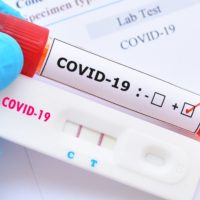24 July 2021
The Background
One of the first documented clusters of what has been deemed COVID-19 was in December 2019 in Wuhan, China when 41 patients with pneumonia were hospitalised.1 The most common symptoms were fever (98%), cough (76%), and myalgia or fatigue (44%). Abnormalities were reported in chest CT images for all patients as would be expected for a diagnosis of pneumonia. Six of the patients died. There were no specific symptoms or general laboratory findings that would allow for classification of a new type of respiratory illness or for a novel pathogen to be implicated as the monocausal agent.
It was reported that, “41 patients were confirmed to be infected with 2019-nCoV. The presence of 2019-nCoV in respiratory specimens was detected by next-generation sequencing or real-time RT-PCR methods.” They reported detection of short target sequences said to relate to the “envelope gene of CoV”.

This was based on the National Health Commission and China CDC reporting they had identified, “the first complete genome of the novel β genus coronaviruses (2019-nCoVs)” on January 3, 2020.2 The sequences were obtained from bronchoalveolar fluid samples obtained from a single designated “case”, not from purified viral particles. Hence there was no proof that the sequences came from any virus, let alone a novel coronavirus.
On 23 January 2020, Corman and Drosten, et al published their diagnostic workflow for, “Detection of 2019 novel coronavirus (2019-nCoV) by real-time RT-PCR”.3 As stated in the introduction, their protocol was designed, “in absence of available virus isolates or original patient specimens.” The hypothetically formulated assays were based on downloading “SARS-related virus sequences” from GenBank and the unvalidated sequence released by the Chinese authorities. Despite reporting, “on the establishment and validation of a diagnostic workflow for 2019-nCoV screening and specific confirmation”, the paper only establishes the analytical performance of the PCR protocol. There is no discussion of the diagnostic specificity of their PCR for a condition that came to be called “COVID-19”. Despite having no established clinical utility, the PCR became the “gold standard” to diagnose “COVID-19” as what was called a “test” was conflated with a diagnosis.
COVID “Cases”
The New Zealand Ministry of Health website states that the clinical criteria for COVID-19 comprises: “Any acute respiratory infection with at least one of the following symptoms (with or without fever): new or worsening cough, fever (at least 38˚C), shortness of breath, sore throat, coryza (runny nose), anosmia (loss of sense of smell), and dysgeusia (altered sense of taste).4. Further it states that a “confirmed case” requires at least one of the following: (1) detection of SARS-CoV-2 from a clinical specimen using a validated NAAT (PCR). Very weak positive results will only be labelled a confirmed case when the result is confirmed on a second sample.
(2) detection of coronavirus from a clinical specimen using pan-coronavirus NAAT (PCR) and confirmation as SARS-CoV-2 by sequencing
(3) significant rise in IgG antibody level to SARS-CoV-2 between paired sera.
Similarly, The World Health Organisation states that a confirmed case can be “a person with a positive Nucleic Acid Amplification Test (NAAT)”5. In summary, a confirmed case is determined solely by laboratory results and this new way of classifying a “disease” was mirrored in most jurisdictions around the world. There is a fundamental problem with regards to classifying disease in this way as the clinical findings and any other investigations are negated. This has been further compounded by the use of Nucleic Acid Amplification Tests as “screening” tests for COVID-19.

NAATs do not establish the presence of intact organisms, they are simply a process to amplify target genetic sequences. There is no history of NAATs being accurate in any epidemic, in fact, the use of PCR kits in 2006 resulted in almost 100% of the cases of an alleged pertussis epidemic being false positives.6 In other words it was a PCR test epidemic, not an epidemic of the disease.
Playing with the PCR in New Zealand
Becker, Vipond, and Mansell stated they had identified, “the the earliest known cluster of SARS-CoV-2 infection so far reported, which occurred in New Zealand in late February 2020” in a paper published in March 2021.7 They diagnosed “COVID-19” in a male in his 60s based on, “a weak positive NPS PCR result (GeneXpert Xpert® Xpress SARS-CoV-2, Cepheid, Sunnyvale, Ca, USA: E gene target CT 40.5; N2 gene 38.2)” and, “serology (Total IgG/IgM by ECLIA, I.R.C.C.S Ospedale San Rafaele Milan, It) was reactive for SARS-CoV-2 antibodies, indicative of past infection.” It again highlights the fundamental issues of what defines a “COVID-19” case and the validity of these purported “tests”. The authors were asked to clarify the following questions in emails that were sent on 27 May and 3 June 2021:
1. What is the case definition of “COVID-19” in your paper?
2. What is the diagnostic specificity of the NPS PCR (GeneXpert Xpert® Xpress SARS-CoV-2) for the condition “COVID-19”?
3. What is the diagnostic specificity of the serology assay (Total IgG/IgM by ECLIA, I.R.C.C.S Ospedale San Rafaele Milan, It) for the condition “Covid-19″?
To date, the authors have not provided any response to these questions.
A further example of this is that the authors make the claim that, “the finding of a weak positive PCR result 201 days (more than six months) after acute infection indicates SARS-CoV-2 genetic material can be detected for several months after initial COVID-19 infection.” Instead of making such a claim, would it not be more reasonable to raise a question about the validity of the PCR test? Additionally, it is known that cycle threshold (CT) values above 34 almost certainly point to an artefact, as this is the limit at which a single target molecule is likely to be present in the sample.8 In this case, to make the “diagnosis”, the CTs were 40.5 and 38.2, levels at which no plausible claims can possibly be made.
PCR Testing Unchecked
The New Zealand Ministry of Health reports that, “a recent laboratory study found that different COVID-19 testing kits correctly detected COVID-19 in samples more than 95% (and frequently 100%) of the time.”9 This is a misleading statement as the PCR cannot “detect” a clinical infection: by definition they can only detect genetic sequences. The statement conflates the test (purportedly for the detection of SARS-CoV-2 genetic sequences) with the clinical condition “COVID-19”. They indicate they are basing the “accuracy” of the tests on a report titled, “SARS-Cov-2 Molecular Assay Evaluation: Results”.10 The Ministry appears to be confusing the analytical specificity of the “SARS-CoV-2” tests with the diagnostic specificity for the condition “COVID-19”.
In 2009, Bustin, et al produced the “Minimum Information for Publication of Quantitative Real-Time PCR Experiments” in response to the, “remarkable lack of consensus on how best to perform qPCR experiments”.11 The MIQE guidelines are considered the guiding document with regards to how RT-PCR should be performed. They clearly state that, “analytical specificity refers to the qPCR assay detecting the appropriate target sequence rather than other, nonspecific targets also present in a sample.”
The study that the Ministry refers to obviously relates to the analytical specificity of the SARS-CoV-2 PCR test. That is they specifically pick up the appropriate target genetic sequences rather than other sequences. An analogy would be a blood glucose test that specifically detects glucose rather than other molecules. Obviously high analytical specificity is essential but it is meaningless without considering the diagnostic utility of the test.
As the MIQE guidelines state, “diagnostic specificity is the percentage of individuals without a given condition whom the assay identifies as negative for that condition.” This is the pivotal issue with regards to the diagnosis of “COVID-19”. While manufacturers of the PCR tests also promote the high analytical specificity of the kits, no other information is given as to what a “positive” test actually means. Incidentally, many manufacturers specifically avoid diagnostic specificity claims by omitting mention of “COVID-19” and include disclaimers that the PCR kits are, “for research use only!”12
There were no clinical studies to establish the diagnostic specificity of the PCR kits for the condition COVID-19 or comparison to a gold standard. Because there are no specific clinical symptoms or confirmatory investigations for COVID-19, the PCR tests have become the standalone tool for diagnosis. It is surprising that there has not been more reservations by clinicians with regards to relying on the PCR for diagnostic purposes. Essentially it is circular reasoning to conclude that the definition of COVID-19 case is a positive PCR test and a positive PCR test means the test subject has COVID-19. Even more concerning is that frequently the COVID-19 “cases” are never seen by a clinician – a technician performs the test and the case is “confirmed” with a positive PCR.
The highly variable results of the PCR tests in the clinical setting became apparent in early 2020. Li, et al reported on 610 hospitalised patients from Wuhan clinically diagnosed with COVID-19, “from whom 241 (39.5%) patients were finally confirmed with COVID-19 with at least one positive RT-PCR test result.”13 The variability in positive and negative results over sequential tests should have led the authors to at least consider that that the RT-PCR tests were completely unfit for diagnostic purposes. However, presumably as they started with the premise that all cases were “COVID-19” with a monocausal aetiology, they concluded instead that there was, “a potentially high false negative rate of RT‐ PCR testing for SARS‐CoV‐2 in hospitalized patients”.
Similar high variability with PCR results were found by Young, et al in their March 2020 paper describing 18 hospitalised patients diagnosed with COVID-19 in Singapore.14 Patients were shown to oscillate between positive and negative results and vice versa, often within 24 hours on serial testing. No commentary was given on why some patients tested negative more often than positive and how this might relate to the diagnostic utility of the test.
Where is the Pandemic?
In the Covid-19 era we have seen widespread PCR “testing” on a scale never seen before. It should be clear that the use of the PCR for diagnosing infection should still be reserved for research use only as indeed the manufacturers of the kits themselves suggest. The “COVID-19” PCR kits were never validated for clinical application and while their analytical specificity is likely to be extremely high, their diagnostic specificity for clinical use remains unknown. It has been pointed out that hospitalised patients purported to have COVID-19 can have negative PCR tests at the peak of their illness while other “cases” are diagnosed with a positive PCR result more than six months after the “acute” illness.
When we were medical students we were taught that clinical diagnosis depends on taking a history, examining the patient, and then, if required, performing investigations. With “COVID-19” this has all been turned on its head. There are no established clinical criteria for what actually defines all these “cases”. By July 2020, a Cochrane Review concluded that, “based on currently available data, neither absence nor presence of signs or symptoms are accurate enough to rule in or rule out COVID-19.”15 Additionally, there are no confirmatory investigations for the alleged condition. This leaves us with the reality that COVID-19 “cases” are still being defined solely by a “positive” PCR result. Surely it is time for the policy makers to admit there is a problem with their “pandemic”? As my Virus Mania co-author Claus Köhnlein has pointed out16, the only pandemic in play is a PCR test pandemic and the whole crisis could be ended by simply stopping their inappropriate use.
References
- https://www.ncbi.nlm.nih.gov/pmc/articles/PMC7159299/
- http://weekly.chinacdc.cn/en/article/id/a3907201-f64f-4154-a19e-4253b453d10c
- https://www.eurosurveillance.org/content/10.2807/1560-7917.ES.2020.25.3.2000045
- https://www.health.govt.nz/our-work/diseases-and-conditions/covid-19-novel-coronavirus/covid-19-information-health-professionals/case-definition-and-clinical-testing-guidelines-covid-19
- https://www.who.int/publications/i/item/WHO-2019-nCoV-Surveillance_Case_Definition-2020.2
- https://web.archive.org/web/20210504212859/https://www.nytimes.com/2007/01/22/health/22whoop.html
- Keeping up with COVID: identification of New Zealand’s earliest known cluster of COVID-19 cases
- https://www.sciencedirect.com/science/article/pii/S2214753517302073
- https://www.health.govt.nz/our-work/diseases-and-conditions/covid-19-novel-coronavirus/covid-19-health-advice-public/assessment-and-testing-covid-19/covid-19-test-results-and-their-accuracy#accuracy
- https://www.finddx.org/covid-19/sarscov2-eval-molecular/molecular-eval-results/
- https://www.gene-quantification.de/miqe-bustin-et-al-clin-chem-2009.pdf
- https://altona-diagnostics.com/files/public/Content%20Homepage/-%2002%20RealStar/INS%20-%20RUO%20-%20EN/RealStar%20SARS-CoV-2%20RT-PCR%20Kit%201.0_WEB_RUO_EN-S02.pdf
- https://onlinelibrary.wiley.com/doi/10.1002/jmv.25786
- https://jamanetwork.com/journals/jama/fullarticle/2762688
- https://www.cochranelibrary.com/cdsr/doi/10.1002/14651858.CD013665/full?highlightAbstract=covid%7Cdiagnos%7C19%7Cdiagnosis%7Cdiagnosi%7Cdiagnoses
- PCR Pandemic with Dr Claus Kohnlein
-
Dr. Samantha Bailey
Sam is a content creator, medical author & health educator.
- Dr. Samantha Baileyhttps://drsambailey.com/author/sam/
- Dr. Samantha Baileyhttps://drsambailey.com/author/sam/
- Dr. Samantha Baileyhttps://drsambailey.com/author/sam/
- Dr. Samantha Baileyhttps://drsambailey.com/author/sam/







